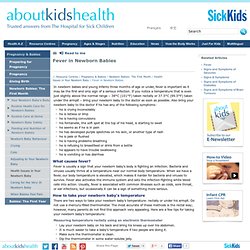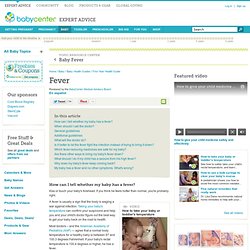

Fever in Newborn Babies. In newborn babies and young infants three months of age or under, fever is important as it may be the first and only sign of a serious infection.

If you notice a temperature that is even just slightly above the normal range – 38°C (101°F) taken rectally or 37.5°C (99.5°F) taken under the armpit – bring your newborn baby to the doctor as soon as possible. Also bring your newborn baby to the doctor if he has any of the following symptoms: he is crying inconsolably he is listless or limp he is having convulsions his fontanelle, the soft spot at the top of his head, is starting to swell he seems as if he is in pain he has developed purple splotches on his skin, or another type of rash he is pale or flushed he is having problems breathing he is refusing to breastfeed or drink from a bottle he appears to have trouble swallowing he is vomiting or has diarrhea.
Fever in a Newborn Fever. Reviewed by the BabyCenter Medical Advisory Board En español How can I tell whether my baby has a fever?

Kiss or touch your baby's forehead. If you think he feels hotter than normal, you're probably right. How to take your baby or toddler's temperature. Fever in children: 5 facts you must know. A recent issue of Pediatrics includes a new report detailing the need for doctors to improve patient teaching about fever and fever-reducing drugs.

Many parents fear their child getting a fever, or have “fever phobia.” I certainly can understand why. Kids can do crazy things when they get fevers. They don’t sleep well, eat poorly, and behave strangely. Some children can even have seizures due to a quick spike in body temperature. Concern about childhood fevers is long-standing in our history. 5 Ways To Treat A Fever Naturally. I Like Math Just About As Much As The Next Mom Counting baby toes, pennies and the number of times Micah says “sooopooon” (spoon) in a day – all good stuff!

But when it comes to my kids health math rarely factors in. Why? I watch them, not the numbers. This is especially true with fevers. I’m not alone, either. “My most frequent calls are from worried parents who want to know how high is too high of a fever. . . . . Loyola Medicine: That Fever Might Be Your Child’s Friend Here’s a video from another pediatrician, Dr. “Seattle Mama Doc” On Fever Phobia Can I just say that I LOVE these woman??
“The main take home is not to treat fever per se, but your child. And here’s what else Dr. “Fevers are safe. There are times you should seek medical attention when your child has a fever such as: Loyola Medicine: That Fever Might Be Your Child’s Friend (emphasis mine) Ahhh, I’m swooning! “There is no ‘number’ on a thermometer that requires a trip to the Emergency Department. What About Febrile Seizures? That fever might be your child's friend. For many parents, discovering their child has a fever can be unnerving.

It’s one of the most common reasons parents call their doctor or bring their child in for medical care. Fevers are just a natural part of many illnesses and, in fact, can be helpful as a child battles an illness. "My most frequent calls are from worried parents who want to know how high is too high of a fever. What many parents don’t realize is that often, fevers are their child’s friend,” said Hannah Chow-Johnson, MD, Loyola University Health System pediatrician and assistant professor in the department of pediatrics at Loyola University Chicago Stritch School of Medicine. Fevers are not pleasant for kids. “Fevers can actually help your child recover more quickly, especially if he or she is battling a viral illness,” Chow-Johnson said.
She shares some facts to help parents better understand fevers. Treating childhood fever naturally, fever childhood. By Kimberly Gallagher The first thing to remember when your child is running a childhood fever is that the fever is not the problem, but rather the body’s way of handling a viral or bacterial infection in the body.

Childhood fever can be intense experiences for child and parent alike. I speak from experience here, since Hailey has had three high fevers since her birth one year ago. She gets up past 104 degrees, which seems very high to me, especially when I compare it to my own fever temperatures that typically don’t go past 102 degrees. Our body temperature goes up as a way of killing the virus or bacteria that is causing sickness. Viral childhood fever often spikes to high temperatures and then come back down, only to spike up again later. Bacterial illnesses are more likely to cause a fever that goes up and stays up for a while before breaking and returning to normal. The danger of high childhood fever comes with convulsions. So, how do we bring childhood fever down in our family?